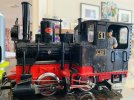I have a 1979 Stainz 2010. It’s been beat to hell for half of the last 40 years, but mostly was still running just fine. A couple days ago, it stated struggling to run forward. Runs smooth in reverse. Forward, it’s going about a third slower than normal, and it sounds like the motor is struggling. I’ve never had it apart, and aside from occasionally pulling cat hair out where I can see it, it’s never had any maintenance of any kind. Any suggestions? I’m somewhat mechanically inclined, and a little less comfortable with electronics.


